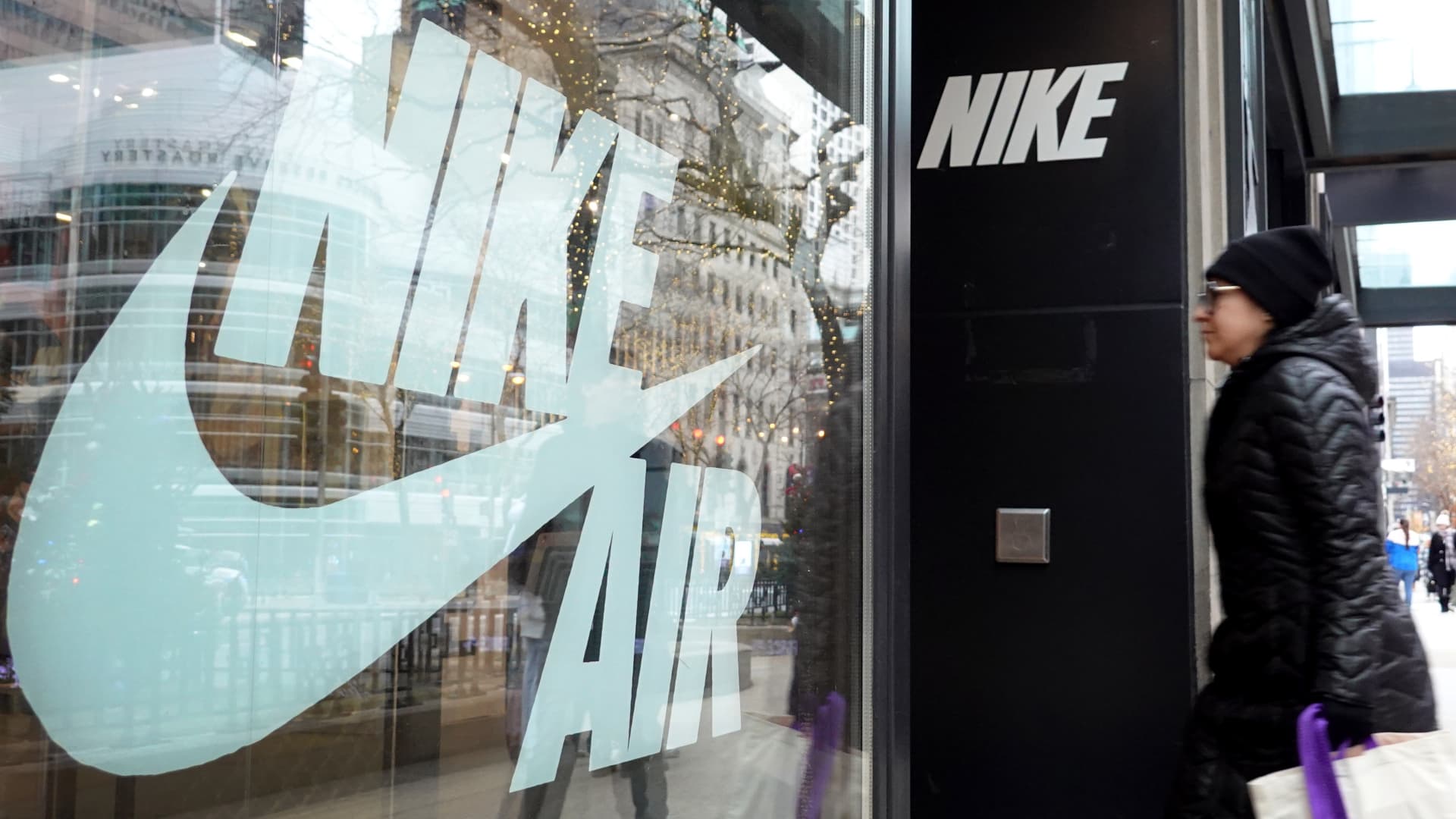A customer enters a Nike store along the Magnificent Mile shopping district on December 21, 2022 in Chicago, Illinois.
Scott Olson | Getty Images
Nike on Thursday unveiled plans to cut costs by about $2 billion over the next three years as it warned about a “softer” revenue outlook for the second half of the year.
The stock fell about 7% after hours. Nike shares were up 4.7% so far this year through Thursday’s close, lagging far behind the S&P 500’s gains for the year. Retailer Foot Locker, which has leaned heavily on Nike products, fell 4% after hours.
Nike plans to simplify its product assortment, increase automation and its use of technology, streamline the overall organization and leverage its scale “to drive greater efficiency,” the company said in a news release when announcing fiscal second quarter earnings.
It plans to reinvest the savings it gets from those initiatives into fueling future growth, accelerating innovation and driving long-term profitability.
“As we look ahead to a softer second-half revenue outlook, we remain focused on strong gross margin execution and disciplined cost management,” finance chief Matthew Friend said in a statement.
The plan will cost the company $400 million to $450 million in pre-tax restructuring charges that will largely come to fruition in Nike’s current quarter. Those costs are mostly related to employee severance costs, Nike said.
Earlier this month, The Oregonian reported that Nike had been quietly laying off employees over the past several weeks and had signaled that it was planning for a broader restructuring. A series of divisions saw cuts, including recruitment, sourcing, brand, engineering, human resources and innovation, the outlet reported.
The company didn’t immediately return a request for comment on The Oregonian’s report.
During Nike’s fiscal second quarter, it posted a strong earnings beat, indicating its cost savings initiatives were already underway. But, for the second quarter in a row, it fell short of sales estimates.
Here’s how the sneaker giant performed compared with what Wall Street was anticipating, based on a survey of analysts by LSEG, formerly known as Refinitiv:
- Earnings per share: $1.03 vs. 85 cents expected
- Revenue: $13.39 billion vs. $13.43 billion expected
The company reported net income for the three-month period that ended Nov. 30 was $1.58 billion, or $1.03 per share, compared with $1.33 billion, or 85 cents per share, a year earlier.
Sales rose about 1% to $13.39 billion, from $13.32 billion a year earlier.
Nike is considered a leader among industry peers like Lululemon and Under Armour, but its profits have been under pressure and its been in the midst of a strategy shift that’s seen it rekindle its relationships with wholesalers like Macy’s and Designer Brands, the parent company of DSW.
Focus on margins
For the last six quarters, Nike’s gross margin has declined compared to the prior year period but the story turned around on Thursday. Nike’s gross margin increased by 1.7 percentage points to 44.6%, slightly ahead of estimates, according to StreetAccount.
This time last year, Nike’s inventories were up a staggering 43% and the retailer was in the midst of an aggressive liquidation strategy to clear out old styles and make way for new ones, which weighed heavily on its margins. Several quarters later, however, Nike is in a far better inventory position, which is a boon for margins.
During the quarter, inventories were down 14% to $8 billion.
Nike’s gross margin turnaround came as the retail environment overall has been flooded with steep promotions and discounts as retailers struggle to convince inflation-weary consumers to pay full price. In September when Nike reported fiscal first quarter earnings, finance chief Matthew Friend said Nike was “cautiously planning for modest markdown improvements” given the overall promotional environment.
The company attributed the gross margin uptick to “strategic pricing actions and lower ocean freight rates,” saying it was partially offset by unfavorable foreign exchange rates and higher product input costs.
As one of the last retailers to report earnings before the December holidays, investors are eager to hear good news when it comes to Nike’s expectations for the crucial shopping season. When many retailers issued holiday quarter guidance in November, the commentary was largely tepid and cautious as companies looked to under promise and over deliver in an increasingly uncertain macro environment.
In its earnings release, Nike didn’t share any insight on guidance but did say it would provide revised guidance during its conference call, scheduled for 5 p.m. ET Thursday. In September, Nike maintained its full-year guidance of revenue growth in the mid-single digits and gross margin expansion of 1.4 to 1.6 percentage points.
China is another key part of the Nike story. As the region emerges from the Covid pandemic and widespread lockdowns, China’s economic recovery has so far been a mixed bag. In November, retail sales climbed 10.1% in the region.
It was the fastest pace of growth since May but those numbers were up against easy comparables and the growth was largely driven by car sales and restaurants, according to a research note from Goldman Sachs.
During the quarter, China sales came in at $1.86 billion, which fell short of the $1.95 billion that analysts had expected, according to StreetAccount. Sales in Europe, Middle East and Africa also fell short of estimates, but revenue came in ahead in the North America, Asia Pacific and Latin America markets, according to StreetAccount.
Read the full earnings release here.
This is a developing story. Check back for updates.


